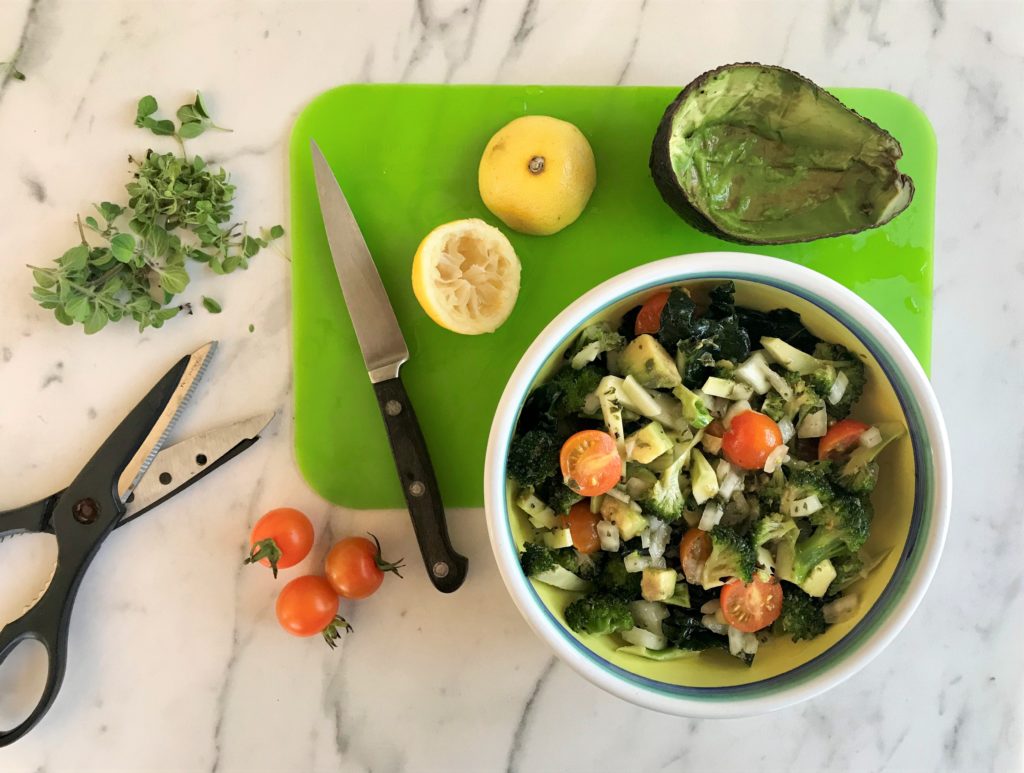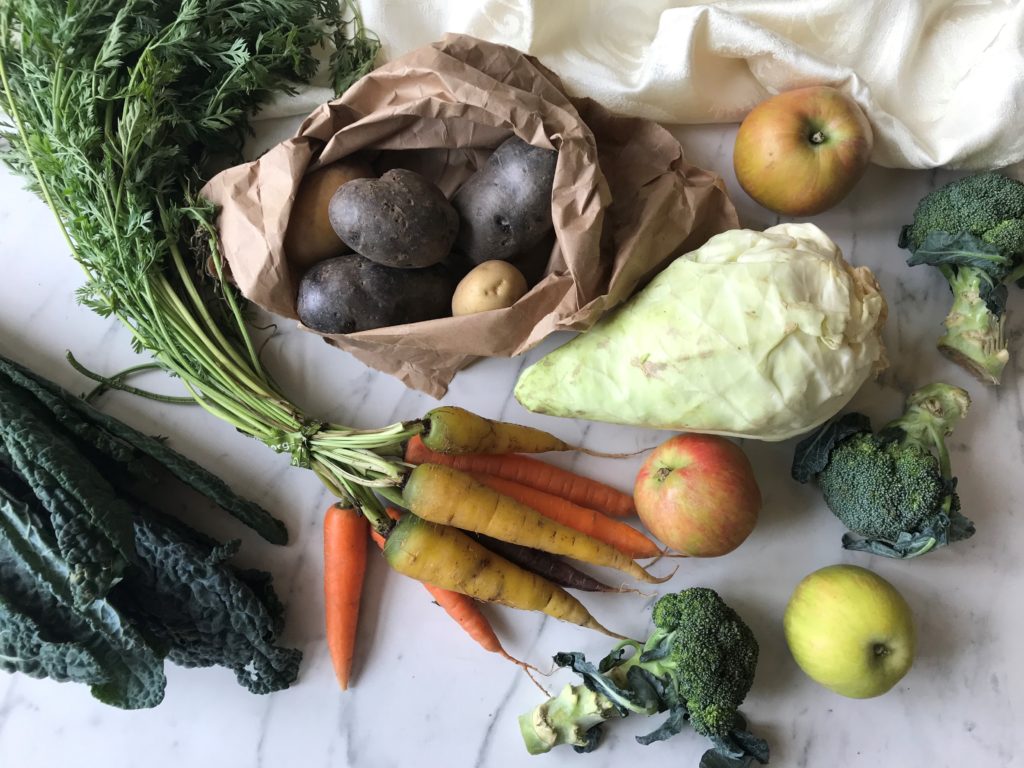
Broccoli Ceviche with Avocado & Sweet Onion
“I’m sick of kale!”
Those were my daughter Allegra’s words. I wondered when she’d need a break from the kale she was eating – sometimes twice daily.
It’s easy to fall into routines of eating the same foods – because we like them, it’s easy, or we’ve mastered preparing them. Allegra likes vegetables and exploring new ways to serve them, so I know she’ll move beyond kale.
It matters. Diets rich in vegetables and fruits are associated with better health – lower blood pressure and blood sugar levels and reduced risk of cardiovascular disease and some cancers (3,4).
Eating a variety makes meals more interesting and boosts nutrition because different produce items have different nutrients. While a direct link to health has not been established, observational research done by the American Gut Project showed that people who ate 30 different plant foods each week had greater diversity in their microbiome than those who reported eating 10 or fewer different plant foods. Eating more plants was linked to lower antibiotic resistance, too (1,2).
Of course, one is better than none. Only one in ten people get the recommended 2 ½ to 3 cups of vegetables and 1 ½ to 2 cups of fruit each day (5). Making them look and taste good helps.
Get veggin’ with Broccoli Ceviche with Avocado & Sweet Onion. There’s no cooking involved so it’s ideal on a warm, end-of-summer day. The broccoli “cooks,” or softens and brightens in color, when it sits in an acidic citrus dressing. It’s the same technique used to make ceviche, Peru’s national dish of seafood marinated in lemon or lime juice and seasonings. Raw (or steamed) vegetables retain more nutrients, too (6).
Kale and cauliflower have been in the limelight lately, but broccoli is no slouch, nutritionally. They’re all in same family of super-food cruciferous vegetables, known for their nutrient density and health-promoting antioxidants and phytochemicals (7).
Broccoli is an excellent source of vitamins C, K1 and folate, a good source of potassium and fiber and has smaller amounts of magnesium, iron and other nutrients. Among broccoli’s impressive phytochemicals is sulforaphane, which has been extensively studied for its antioxidant, antimicrobial, neuroprotective, anti-diabetic and anti-cancer properties (8,9).

Need inspiration to eat more or different vegetables and fruits? Visit a farmer’s market or store with a well-curated produce department. I found the broccoli for this recipe at the Carnation Farms Farm Stand.
Broccoli Ceviche with Avocado and Sweet Onion
There’s little wasted in this salad, which uses the leaves, florets and stems. It’s important to thinly slice the florets and stems so they “cook” or soften when marinated in the dressing. Make it a few hours or even a day ahead, adding delicate items just before serving.
Serves 6
¾ pound broccoli
1 cup chopped sweet onion such as Walla Walla
1 cup halved cherry tomatoes or ½ cup thinly sliced red radishes
1 cup diced avocado
½ cup crumbled feta or goat cheese, optional
Lemon-Herb Dressing:
4 tablespoons fresh lemon juice
2 tablespoons chopped fresh oregano or thyme
1 tablespoon Dijon mustard
1 tablespoons honey
¾ teaspoon kosher salt
6 tablespoons olive oil
- Make dressing: in the bottom of a large salad bowl, whisk together all ingredients for dressing except the olive oil. Make sure salt is dissolved, then whisk in the olive oil. Set aside.
- To prep the broccoli, cut the florets into small, bite-sized pieces. Trim any leaves slice and reserve. Peel the stems, slice lengthwise and then cut cross-wise into small pieces. Add to dressing along with onion. Cover and chill for 3 hours or up to allow broccoli to soften and “cook” in the dressing.
- To serve, stir in cherry tomatoes, avocado and cheese. Toss and serve.
Options:
- Add a cup of cooked corn kernels. (Grill the cob for best flavor).
- Instead of avocado and cherry tomatoes use 1 cup fresh, pitted cherries, ½ cup dried cherries and add a handful of toasted pecans.
References:
- The American Gut Project
- ‘Largest’ microbiome study weighs in on our gut health. By Ana Sandoiu and Fact checked by Jasmin Collier. May 15, 2018. Medical News Today.
- Low fruit and vegetable intake may account for millions of deaths. By Chiara Townley and fact checked by Jasmin Collier. June 14, 2019. Medical News Today.
- The Nutrition Source. Vegetables and Fruits. Harvard t.H. Chan School of Public Health.
- CDC Newsroom Press Release: Only 1 in 10 Adults Get Enough Fruits or Vegetables. November 16, 2017 l
- Effects of different cooking methods on health-promoting compounds of broccoli. Gao-feng Yuan,1 Bo Sun,1 Jing Yuan,1 and Qiao-mei Wang. J Zhejiang Univ Sci B. 2009 Aug; 10(8): 580–588. Journal of Zhejiang University Science.
- Foods That Fight Cancer: Broccoli & Cruciferous Vegetables. American Institute for Cancer Research.
- Broccoli: Health Benefits, Risks & Nutrition Facts.
By Jessie Szalay. June 15, 2017. Livescience.com
9. Current potential health benefits of sulforaphane.
Jae Kwang Kim1 and Sang Un Park. EXCLI J. 2016; 15: 571–577.
© Lorelle Del Matto 2019
 About lorelle
About lorelle
Speak Your Mind